Music Theory & Writing
Introduction
Hughes has experimented with several recognised styles of composition and pitch organisation, ranging from modal and post-tonal theory through to the use of serialism, microtones and electronics. Several unique and elaborate systems of sonic organisation have emerged from this, forming an integral part of his style of composition. Although some of his works adopt a number of methods which look outside of the realm of the 12-tone Pythagorean system adopted in Western art-music (i.e. by using natural harmonics, microtones, electronics etc...), the core of his most recent work has centred on a number of methods that act as a hub between modal and chromatic styles of writing.
Hughes is a technically skilled composer and his work is broad ranging in scope and demonstrates a high level of variety and versatility, along with the ability to compose convincingly, with stylistic accuracy in a plethora of historical classical and non-classical genres. Some of his pieces are unashamedly modal in style (in particular his works for amateur-level singers and choirs); however, the majority of his recent work is a great deal more chromatic and avant-garde in style. Hughes also often experiments with extended instrumental and vocal techniques and electronics in order to add timbral effects, colouration and atmospherics to the sonic world created in his music language.
The majority of Hughes’s most recent acoustic compositions adopt some form of post-tonal, post-impressionistic chromaticism, leaning towards the polymodal chromaticism which is coined in many of the chromatic and twelve-tone works of Béla Bartók and Olivier Messiaen (and also alluded to in Messiaen’s Technique of My Musical Language). Serialism and the expressionist methods of the Second Viennese School also form an influence on Hughes’s use of pitch; however, various serial techniques (such as hexachordal rotation or pentachordal rotation) tend to be adopted in an auxiliary fashion in Hughes’s work and are rarely employed in a strict didactic manner. There is a correlation between Hughes’s use of rotation-based serial techniques and that which is seen the works of several modern British serialists, including Oliver Knussen and Julian Anderson.
Polymodality, polyharmony and the use of polychords form the basis of Hughes’s most radical style of pitch organisation, which is complex and elaborate and he has devised his own unique system for combining chromatically related modal patterns in different ranges of the pitch spectrum (coined as stacked polymodality). Please refer to the Polymodes section on this page of this site for further information; there is also a Wikipedia page on this topic.
Below is a sample of some of Hughes’s academic writing on the methods adopted in his compositional work. Further written material by Hughes is available in the academic commentary to his PhD portfolio (volume 2 [of 2]), available for download in PDF format via the following weblink to Cardiff University’s electronic theses archive:
View Hughes's PhD Portfolio: http://orca.cf.ac.uk/87839/Pitch Organisation Models
The pitch organisation methods in the majority of my compositional work adopt some form of modality and/or polymodality (operating in several chromatically related modes simultaneously1), as well as row-based, serial and intervallic methods. Here is an illustration of some of the core theoretical ideas and models that I adopt:
Modes
Both the Lydian2 and Dorian mode are adopted predominantly in my modal and polymodal systems. I effectively treat the Dorian mode as the ‘relative minor’ equivalent to its Lydian mode counterpart. This is the by-product of many years of composing with these modes as well as working with them in jazz, folk and other styles of improvisatory music. I have always liked the bright sound which these modes possess and prefer them to the, perhaps more conventional, Ionian and Aeolian modes adopted predominantly in western art-music prior to the twentieth century.
I regard the Lydian mode to be brighter than the Ionian mode due to the augmented fourth interval which exists from its root (as opposed to a perfect fourth) and consequently the greater number of sharpened intervals which it possesses (i.e. C Ionian is neutral whereas C Lydian has one sharp, G Ionian has one sharp whereas G Lydian has two sharps etc... similarly of their respective relative minor modes: A Aeolian is neutral whereas A Dorian has one sharp, E Aeolian has one sharp whereas E Dorian has two sharps etc...).
Both modes can also be used to construct the bright and colourful polychords shown in the examples based on white-note modes below:


Another feature in my modal and polymodal systems is the idea of upper/lower-structure chords or patterns being in operation within a specific pitch region as illustrated above.
It is often a characteristic of my style that one mode floats chromatically to the next without a conventional modulation or cadence (as would be seen in western art-music prior to the twentieth century), thus conventional cadences are relatively infrequent; however, some examples of harmonies with a conventional dominant function do occasionally occur and I adopt special chromatic modes for this purpose. Such modes might similarly be seen in the style of impressionist or post-impressionist composers (i.e. Debussy, Ravel, Messiaen), Bartók, Stravinsky or various styles of modern jazz. Below is an example of three modes with harmonic blocks that might form the basis of typical cadences:



Note that the accidental spellings on the upper/lower-structure chords occasionally differ from the logical spelling used on the mode shown in isolation on the left (i.e. in Fig 1.1.3 & 1.1.5 the lower-structure chord uses C♯ rather than D♭ – this is to clearly show that the lower-structure chord is an A dominant 7th, which should normally be spelt with a C♯). Slight modifications of this nature are often made so that the upper/lower-structure chords within a polychord are spelt in a natural way.
Pentatonic modes are also frequently used in my work. If we look at a Lydian mode on F (or any 7-note white-note scale for that matter) 3 separate major pentatonic scales can be extracted from it as shown below:

Pentatonic modes work well when used for upper-structure melodic/harmonic patterns as illustrated in the two following examples:
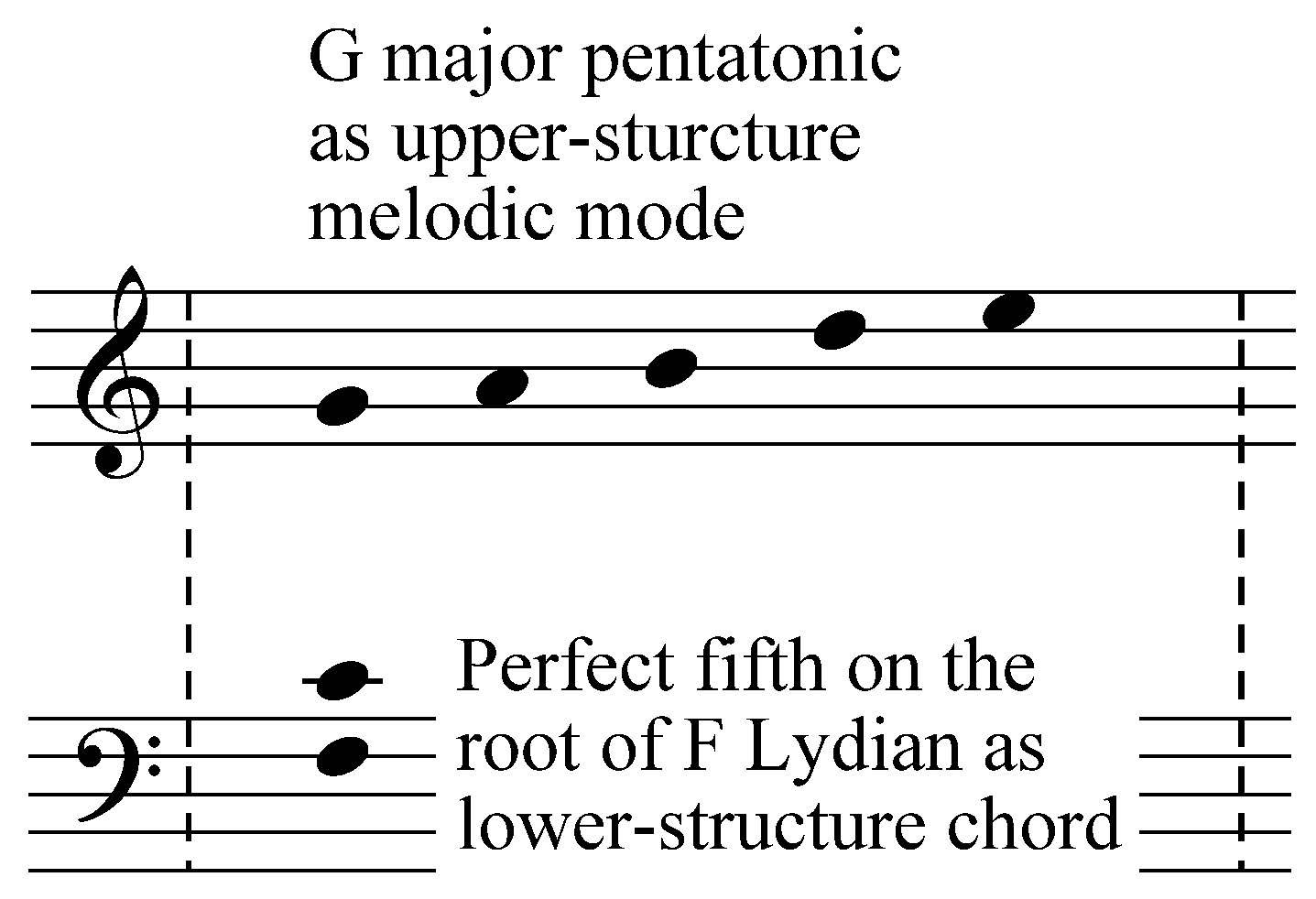
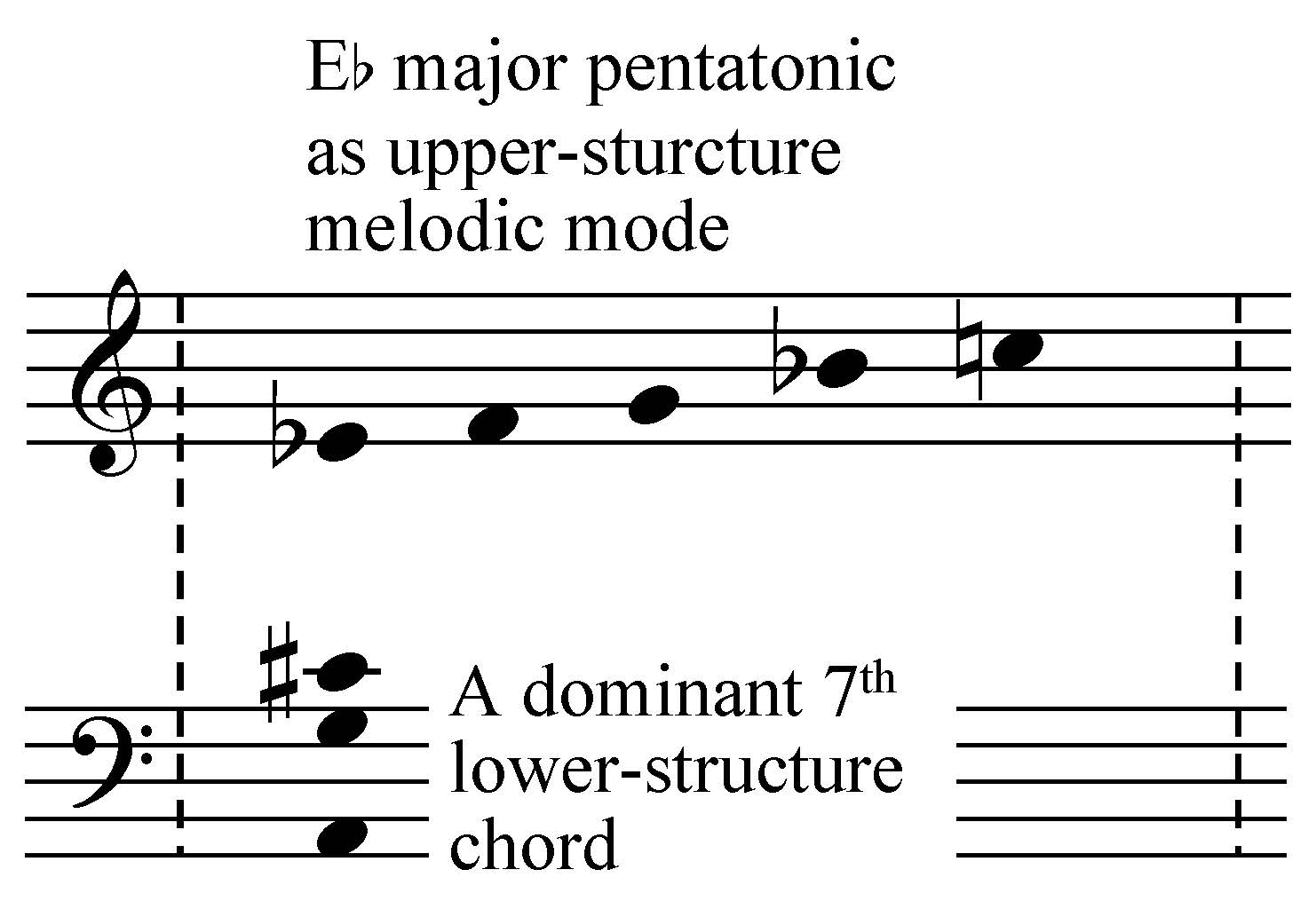
Fig 1.1.8 uses all the pitches of the altered scale on A as shown in Fig 1.1.3
There is a subjective avoidance of symmetrical scales and arpeggios in my work (in particular the chromatic, whole-tone3, hexatonic, octatonic4 scales and diminished 7th arpeggios). This is a decision which I have consciously made as a composer as I generally find the sound of repeated symmetrical patterns to be somewhat monotonous and lacking in subtlety – that said, highly effective use of symmetrical patterns has been seen in the work of composers such as Debussy and Stravinsky: The whole-tone scale (i.e. C–D–E–F♯–G♯–A♯–C) is utilised very successfully in works such as Debussy’s solo piano piece Cloches à travers les feuilles (from Images, Set 2, 1907) and his operatic work Pelléas et Mélisande5 (1898), as well as Paul Dukas’s Ariane et Barbe-bleue6 (1906); of the two latter works, Messiaen states in The Technique of My Musical Language that both works “have made such remarkable use of it [the whole-tone scale] that there is nothing more to add. Then we shall carefully avoid making use of it, unless it is concealed in a superposition of modes which renders it unrecognizable”.7
In a similar vein, remarkable use of the octatonic scale (i.e. C–C♯–D♯–E–F♯–G–A–B♭–C) has already been seen extensively in much of Stravinsky’s work, as seen in works such as his ballet Petrushka (1910–11) – this includes the recurrence of its (in)famous ‘Petrushka chord’ extracted from the pitches of a single octatonic scale, which juxtaposes two major triads a tritone apart and recurs in various horizontal or vertical formations throughout the work. Bartók has made remarkable use of the hexatonic scale (i.e. [C–D♯–E–G–A♭–B–C], otherwise known as the ‘magic hexachord’) in pieces such as the third movement of the Concerto for Orchestra (1943) marked “Elegia” Andante non troppo to create an evocative and mystical musical ambiance.
However, one intention with the use of modes in much of my own work is to avoid any obvious cliché that might cause the music to sound as if it could have been composed a hundred years ago and the overuse of explicit symmetrical modes, such as the whole-tone or octatonic scale might lead to this. One of the features of diatonic and pentatonic modes is their asymmetry and this is what gives them their subtlety; this is a feature of modality that I am interested in exploring further as I develop my (poly)modal methods and style. It is, however, worth noting that the first four notes of the Lydian mode make up part of a whole-tone scale, similarly, the first five notes of the Lydian (♯5) mode are whole-tones, therefore patterns using these modes will frequently make use of their whole-tone portions and might occasionally give the impression of using the whole-tone scale without actually doing so in an explicit fashion.
Polymodes
Fig 1.1.1 illustrates how a Lydian mode is used as the basis for an F major 13th 7-note modal polychord. Similarly, Fig 1.1.2 illustrates how a Dorian mode is used as the basis for a D minor 15th 8-note polychord. A feature of both of these chords is that their consecutive intervals always alternate between a major and minor third. However, if one were to continue this pattern on the F major 13th chord the next pitch in the series would be an F♯ rather an F♮ – a pitch which does not belong to the Lydian mode on F. This idea creates a polychord which effectively has two different pitch regions in two different keys simultaneously. This new pattern can be used as the basis for forming a polymode which combines two different Lydian modes in two differing pitch regions:

This polychord (which is a signature chord in my work and frequently occurs in some guise) now features an interesting ‘false relationship’ between F♯ and F♮. In this particular instance it is logical to describe the interval between these pitches as an ‘augmented octave’ or ‘augmented fifteenth’ rather than a compound minor 9th or minor 2nd, because of the modal relationship which exists between these two pitches (i.e. as the upper structure of the polymode/polychord is based on G Lydian it is normally logical to think of the top pitch as an F♯ rather than a G♭). It is also interesting to note that despite the false relationship the polychord retains a consonant and neutral sound.
The polychord effectively stacks two major 7th chords a major 9th apart on top of one another and the polymode created from this chord stacks two Lydian modes a major 9th apart on top of one another (with an auxiliary note added to link the two modes). This pattern can be continued for a further two octaves to produce an extended polymode and polychord as shown below:

All twelve chromatic pitches operate simultaneously in this extended polychord. It also passes through each respective interrelated major/minor 7th chord in a cycle of fifths as it moves upwards through the pitch spectrum. This is illustrated in the diagram below, which uses colours to help with visually differentiating between each chord:
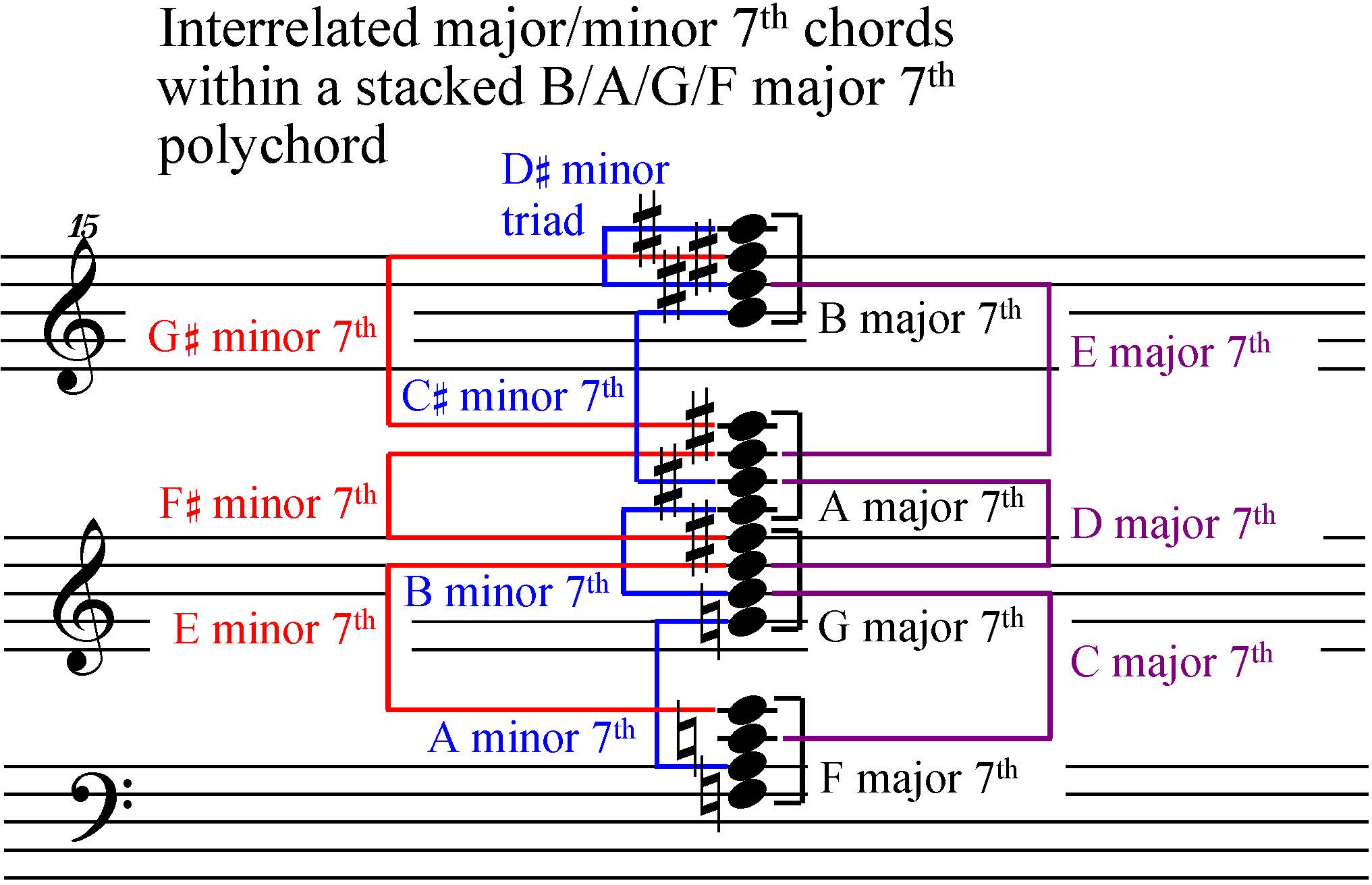
Similarly the extended polymode passes through each respective interrelated Lydian/Dorian in a cycle of fifths as it moves upwards through the pitch spectrum:

If we think of F3 as being the ‘root’ of the polymode above, it is an interesting feature of this polymodal system that transposing the polymode up or down an octave would effectively ‘change key’, thus each individual pitch within the pitch-spectrum has, in effect, its own unique key with an ‘absolute root’. As a consequence, there is a subjective avoidance of consecutive octaves in my style of composing. I also frequently (but not exclusively) try to avoid doubling the same pitch class at the octave within an individual harmonic block; however melodic or contrapuntal material based on each block might include auxiliary notes which double at the octave without forming part of an individual block.
This polymodal system differs from the technique described as “polymodal chromaticism” by Bartók8 in relation to his own polymodal style, where multiple chromatically related modes operate simultaneously whilst sharing a common root (e.g. in Mikrokosmos No.80 [“Hommage à Robert Schumann”, from Book III, 1926–39]) C-Phrygian/Lydian are employed simultaneously comprising all twelve pitches of the chromatic scale [C–D♭–E♭–F–G–A♭–B♭/C–D♮–E♮–F♯–G–A♮–B♮]). Here, Bartók juxtaposes chromatically related modes within the same pitch regions, which differs from my own polymodal style in which chromatically related modes are superimposed (or ‘stacked’) in different regions of the pitch spectrum.
Another well-known early twentieth century work to adopt this form of polymodal chromaticism was Poulenc’s Mouvements Perpetuels, I. (1918),9 which includes passages which stack a B♭ major (or Ionian mode) ostinato pattern in the left-hand below a B♭ Phrygian or Locrian hexachord-based melody (i.e. employing B♭–C♭–D♭–E♭–G♭–A♭) in the right hand. This comes closer to the stacked polymodal system which I adopt in my own work because there are chromatically related modes in operation in different regions of the pitch spectrum; however, a key difference to emphasise is that the Poulenc example employs two modes which share a common root of B♭, whereas in my own system I frequently employ modes in different pitch regions which do not share a common root. To illustrate this, consider the polymode in Fig 1.2.1: I regard F♮3 to be the absolute root of this polymode; however, the upper structure mode is G Lydian (which does not contain an F♮) and the auxillary note which links F Lydian and G Lydian is F♯4, therefore it cannot properly be said that various octave transpositions of F♮3 (namely F♮4 or F♮5) are also roots because they do not feature in the polymode. However, the fact that G Lydian forms the upper-structure to this polymode does not mean that multiple roots are in operation, instead G Lydian is an interrelated collection which forms part of larger synthetic/extended polymode with a common absolute root of F♮3.
The stacked Lydian/Dorian polymodes illustrated in Figures 1.2.1–4 are employed exhaustively in my style and might be regarded as typical type of ‘pure-form’ polymodes. If we consider these polymodes, the interval from one adjacent pitch to the next is always either a major or minor second but it avoids the inclusion of two adjacent minor second intervals – this is a characteristic which such polymodes share with conventional diatonic scales. As a consequence I subjectively avoid the inclusion of trichords which consist of two adjacent minor seconds within any individual harmonic block, as illustrated below:

However, the following trichords are frequently seen within individual harmonic blocks:

It is, of course, logical to add harmonic variety by deviating from the pure-form Lydian/Dorian polymodes as any musical passage runs its course and one way of doing this is by ‘omitting’ a particular pitch-region within the pure-form series and then shifting other regions within the series up or down a specified number of octaves. For example, if I were to remove the G Lydian and B Lydian portions from the polymode in Figures 1.2.2–4 and then shift the A Lydian portion down an octave (adding a couple of auxiliary notes to link the two Lydian modes) I might produce the following new polymodal pattern:

Similarly, if I were to remove the G Lydian and A Lydian portions and then shift the B Lydian portion down two octaves I might produce the following pattern:

The above diagram also illustrates the possibility of re-voicing the upper structure B major 7th chord (so that it is in 2nd inversion position) as a means of avoiding the slightly unnatural gap between the two root position major 7th chords.
Another method of changing the ‘shape’ of a pure-form polymode is to vary its range of an interralted mode within the series (e.g. I might change mode after a fifth or two octaves rather than every octave). Thus the rate of change of the stacked Lydian/Dorian modes will be compressed or expanded respectively from its pure form. The following example shows an expansion of the polymode seen in Fig 1.2.1:

Note that the above polymode is very close to actually being modal and the false relationship does not occur until the final high F♯ in the series. Another point to clarify here is that when a root mode (in this case F Lydian) is expanded in this way, it opens up the possibility of multiple roots being shared on octave transpositions of the same pitch-class: because F Lydian has been extended for two and a half octaves in the above polymode, this means that F3, F4 and F5 can all be regarded as roots but F6 cannot because it does not feature in the polymode.
The following example shows a compression of the polymode seen in Fig 1.2.1

Generally, expanding a polymode will reduce the perception of chromaticism and shift it towards modality whereas compressing a polymode will do the opposite and increase the perception of chromaticism.
These methods of generating and modifying polymodes open up the idea of visualising an ‘invisible’ (or hidden) polymode/polychord which spans the entire musical pitch spectrum. Then when we have harmonic sequences each individual harmonic block within the sequence contains a new invisible polymode/polychord. Examples of this technique will feature later on in the commentary relating to a harmonic analysis of sections within some of the pieces in the portfolio.
There is a complexity to the theory behind such a system, however I have found that adopting and developing these theories over a continuous period of time has meant that extracting interesting pitch material from a corresponding invisible polymode has become second nature to me, leading to a system of pitch organisation which is both unique and elaborate but also practical enough to work with nonetheless.
Rows & Serial Techniques
When adopting rows in my work, I will generally think of them as defining the individual pitch-classes used for the purposes of constructing individual harmonic/melodic blocks, without necessarily defining the exact octave within the pitch spectrum where that particular pitch-class might occur – this differs from the interrelated polymodal system previously illustrated which does define the exact octave for each individual pitch within it. Any individual pitch-class should not be repeated within a row, therefore when adopting rows which contain more than 7 individual pitch-classes I will always be working with an initial set which ventures outside of the realms of any individual 7-note diatonic mode – thus the row is treated as being part-modal and part-chromatic/polymodal.
Rows are rarely adopted explicitly in my recent compositional work; by this I mean that one would be unlikely to find many examples of rows which are repeated, retrograded, inverted and transposed continually (as is the case in serial and other row-based works by pioneers in this field such as Schoenberg or Webern). Instead, rows are normally adopted as tools (in an auxiliary fashion) to help me create individual polymodal harmonic/melodic blocks and there is often a new row for each constituent block rather than a repetition of the same prime row or some transformation of it.
A row might be constructed from the first eight pitches of the ploymode in Fig 1.2.1 (also equivalent to the individual pitch-classes in the stacked G/F major 7th polychord on the right-hand side of the same figure):

The above 8-note row (on the left-hand side) possesses palindromic characteristics: If inverted about F♯4 it produces a retrograde of exactly the same row; when inverted about any other pitch it will produce a transposed retrograde; in addition, when the leftmost polychord is inverted about B♮5 it produces the rightmost polychord, which contains two tetrachords with exactly the same notes as the former.
Similarly a 9-note row might be constructed from all nine of the individual pitch-classes which occur in the ploymode in Fig 1.2.1 (adding a C♯ to the row in the previous example):

If the above row is inverted about F♯4 it produces an interesting result with a perfect fifth at the bass end of the row:

A 10-note row might be constructed from the individual pitch-classes of a stacked A/G/F major 7th polychord and inverted as in the two following examples:


Similarly, an 11-note row might be constructed from the individual pitch-classes in a stacked E/A/G/F major 7th polychord and inverted as shown in the two following examples:


When the above trend is extended to a 12-note row a typical result would be a row with a 7-note diatonic mode as one set (thought of as a heptachord) which leaves a 5-note pentatonic mode (or pentachord) when rotated as shown in the next two examples:


This way of arranging 12-note rows is a form of ‘literal pitch-class complementation’ (where an ‘aggregate’ is divided into smaller subsets, each containing pitch-classes absent from the other(s)10) and is similar, in principle, to the technique of hexachordal rotation seen extensively in Schoenberg’s works, as well in many of the late works of Stravinsky, Krenek and more recently in the works by contemporary British composers such as Oliver Knussen and Julian Anderson. One clear differentiation to make here is to emphasise my tendency to extract an asymmetrical 7-note or 5-note mode (such as a diatonic or pentatonic mode) from the row. As previously mentioned, there is a subjective avoidance of symmetrical scales in my work and when working with hexachordal rotation the resulting hexachords tend to imply symmetry (e.g. 6-note modes/scales such as such the whole-tone scale, the hexatonic scale, or six-note collections from the octatonic scale). Rotating seven or five notes instead tends to lead to the resulting heptachords/pentachords being asymmetrical in one way or another. Summarily I would describe the serial rotation techniques which I adopt in my work as either “heptachordal rotation” or in some cases “pentachordal rotation.”
I also often work with hybrids of some of the patterns in the row-based examples above, for example if I were to create a type of 12-note hybrid of the rows in Figures 1.3.8–9 I might produce the following result:

Note how the pentachord in Fig 1.3.8 has been split into a dyad plus a trichord and some of the black notes have been shifted below the register of the white-note heptachord. Similarly, the heptachord in Fig 1.3.8 could be split as illustrated in the following example:

An interesting feature in the above example is that the polychord on the right-hand side is made up of two hexachords, which imply asymmetrical diatonic modes, illustrating the fact that it is, of course, possible to do this with hexachords in certain circumstances.
As illustrated in Figures 1.3.1–7, I will frequently be working with rows which contain less than twelve individual pitch classes but the principle of rotating asymmetrical heptachords or pentachords will still apply in the same way. Similarly, I might sometimes extend a row to more than twelve pitches for various pragmatic reasons. As an example, the stacked B/A/G/F polychord in Figures 1.2.2–3 contains all twelve pitch-classes and four of the pitch-classes are also doubled at the octave (namely A♮, E♮, B♮ and F♯) – in appropriate circumstances this type of harmonic/melodic block might be thought of as a type of 16-note row.
Intervallic Cells
In order to create a logical interface between (poly)modality and chromaticism in my work, I have devised a set of intervallic cells which are commonly seen in some of my most recent compositional work. This idea owes itself, in part, to the ideas of theorist David Lewin, who was a pioneer in approaching the analysis of works by Schoenberg, Webern and Alban Berg in this way, deducing typical intervallic cells adopted in the work of each respective composer. Lewin’s analysis of Berg’s opera Lulu derived several intervallic cells typical in the composer’s work (i.e. z-cell, y-cell, x-cell), which could be linked to the post-tonal, post-chromatic origins which are transparent in Berg’s work. A similar approach was also applied to the analysis of intervallic cells linked to chromatic polymodality in Bartók’s work by scholars and theorists such as George Pearle and Benjamin Suchoff, in particular the z-cell (which combines two tritones a semitone apart [i.e. C–D♭–F♯–G]) and the x-cell (four adjacent semitones [i.e. C–D♭–D–E♭]).
The typical intervallic cells which I have applied to my own work are based on pitches and the exact intervals which occur in the polymodes which I adopt, but are not closely related to more conventional modal or tonal melodic/harmonic patterns. I am particularly fond of the major 7th and augmented octave intervals which occur in the pure-form stacked Lydian polymode (i.e. if we consider the first eight pitches within this polymode: F–G–A–B–C–D–E–F♯, I often extract the major 7th which occurs between F—E and the augmented octave which occurs between F♮—F♯), thus I divide each cell into a lower and upper structure pitch collection, where the lowest pitch in the upper-structure is either a major 7th or an augmented octave above the lowest pitch in the lower-structure. The lower and upper portion each contain between one and four individual pitch-classes (thus the maximum number of individual pitch-classes possible within the cell is eight [i.e. a lower-structure tetrachord plus an upper-structure tetrachord]). If a lower or upper-structure portion is a dyad then its two pitches must be either a major 2nd or a major 3rd apart (i.e. F+G or F+A); if it is a trichord then it must contain two adjacent whole-tones (i.e. F+G+A); if it is a tetrachord then it must contain three adjacent whole-tones (i.e. F+G+A+B, making it a Lydian mode tetrachord over a tritone).
A table containing these intervallic possibilities is provided below (Fig. 1.4.1, on an F♮ root). I have also given each cell its own unique label (e.g. 3+2e) where the leftmost digit represents the number of pitches in the lower-structure, the rightmost digit represents the number of pitches in the upper-structure and the letter at the end is unique to that exact cell. These labels are useful for the purposes of analysis and deducing these cells from the intervallic patterns in my work.
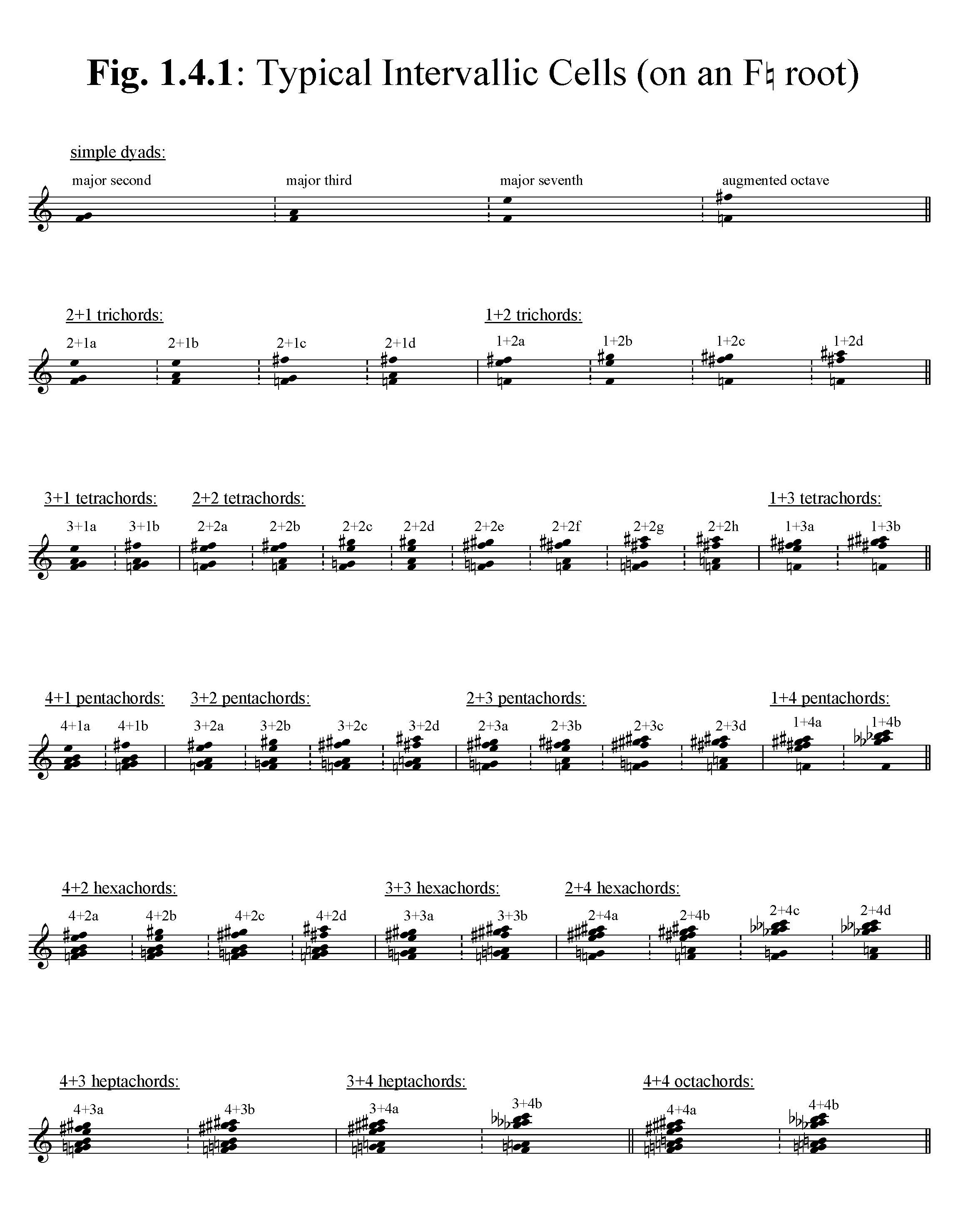
Analysis Diagrams
Below are sample analysis diagrams, illustrating the use of some of the above pitch organisation techniques in Hughes’s compositional work. Figures 2.2.2, 2.2.3, 2.2.5, 2.2.6, 2.2.7 and 2.2.8 are models of various polyharmonic/polymodal blocks constructed in Galargran (Elegy) the middle movement of Cwyn y Gwynt (The Wind’s Lament) for flute & harp:


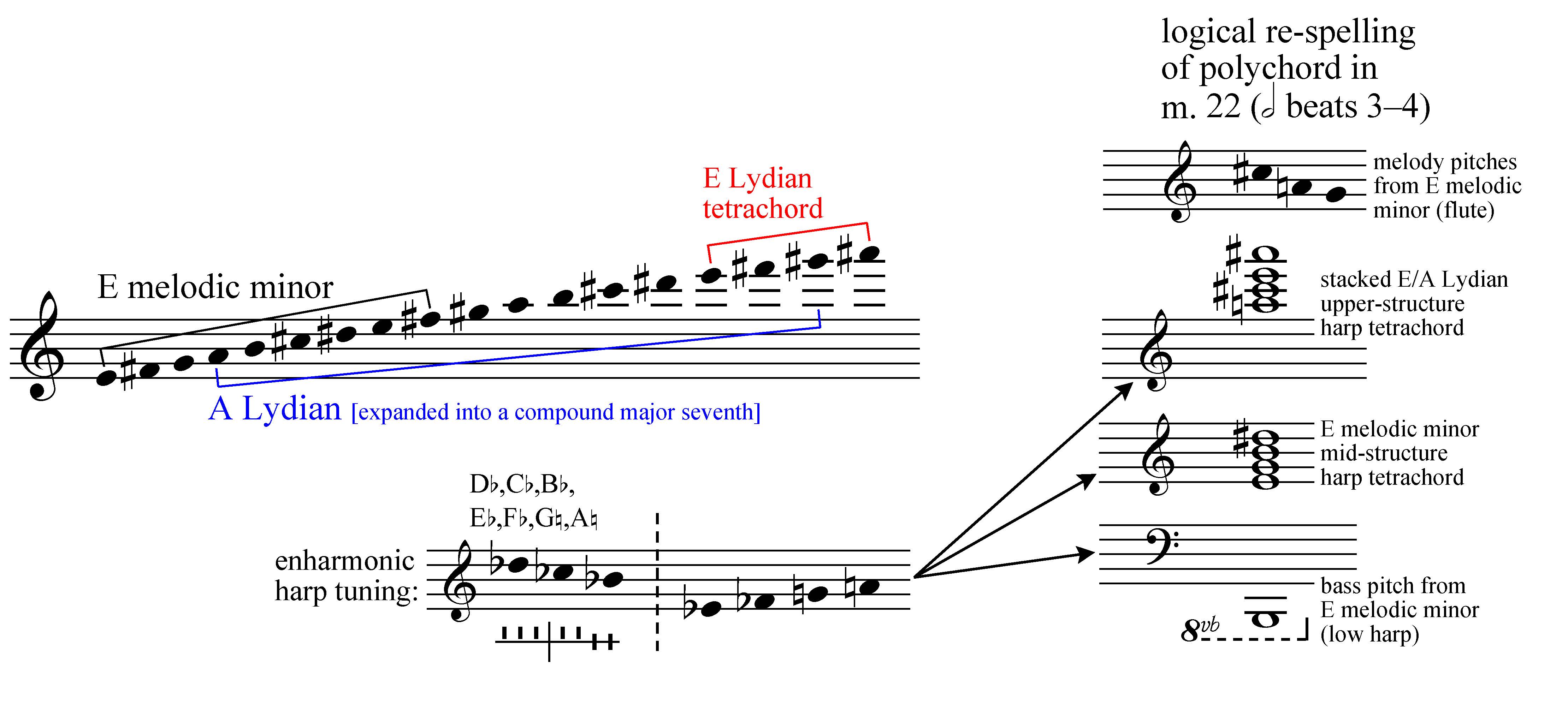
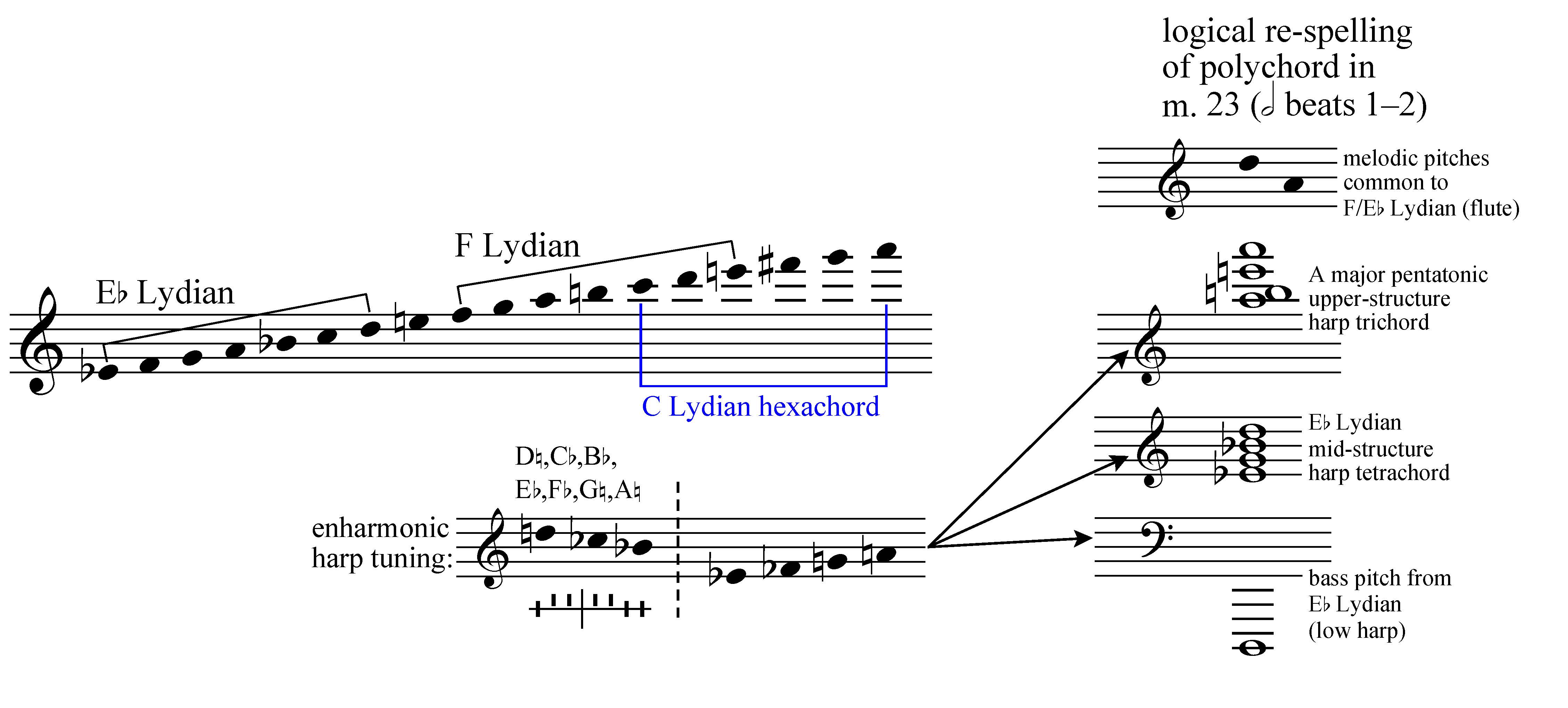
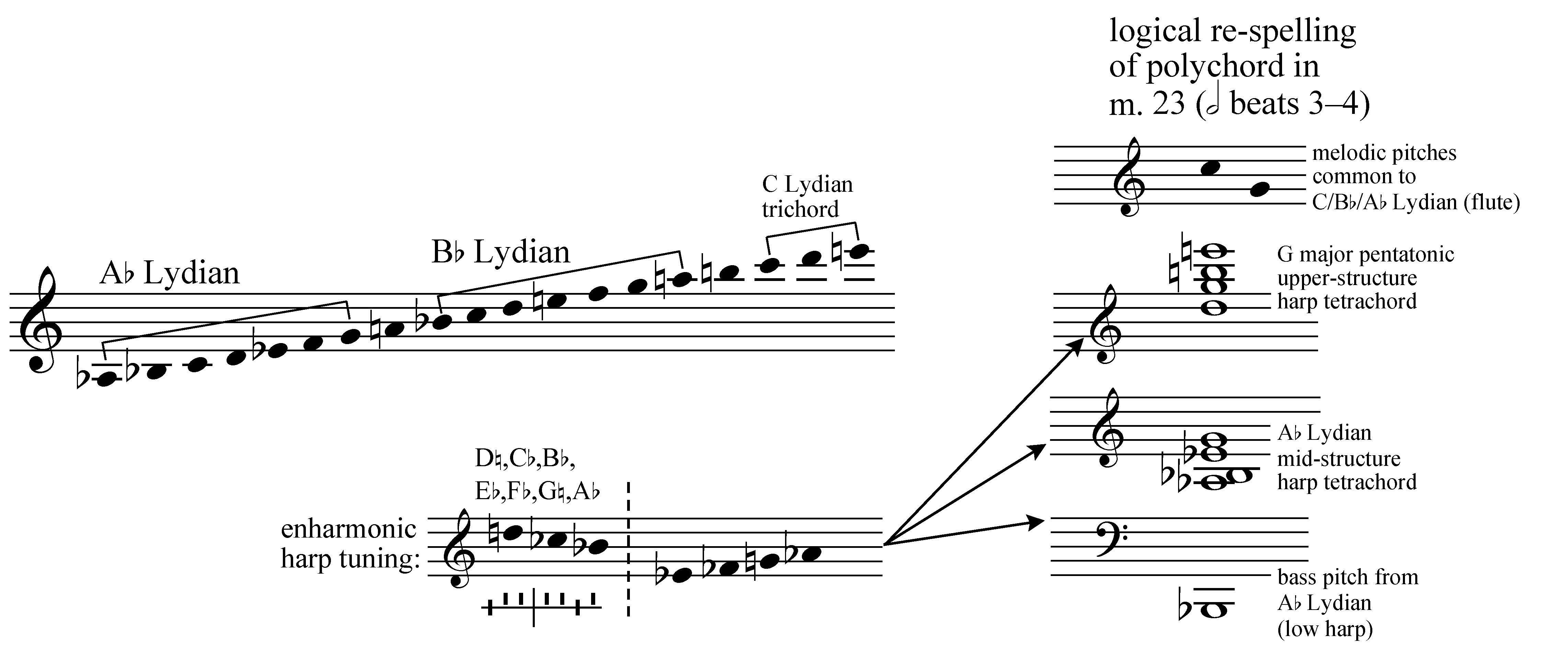
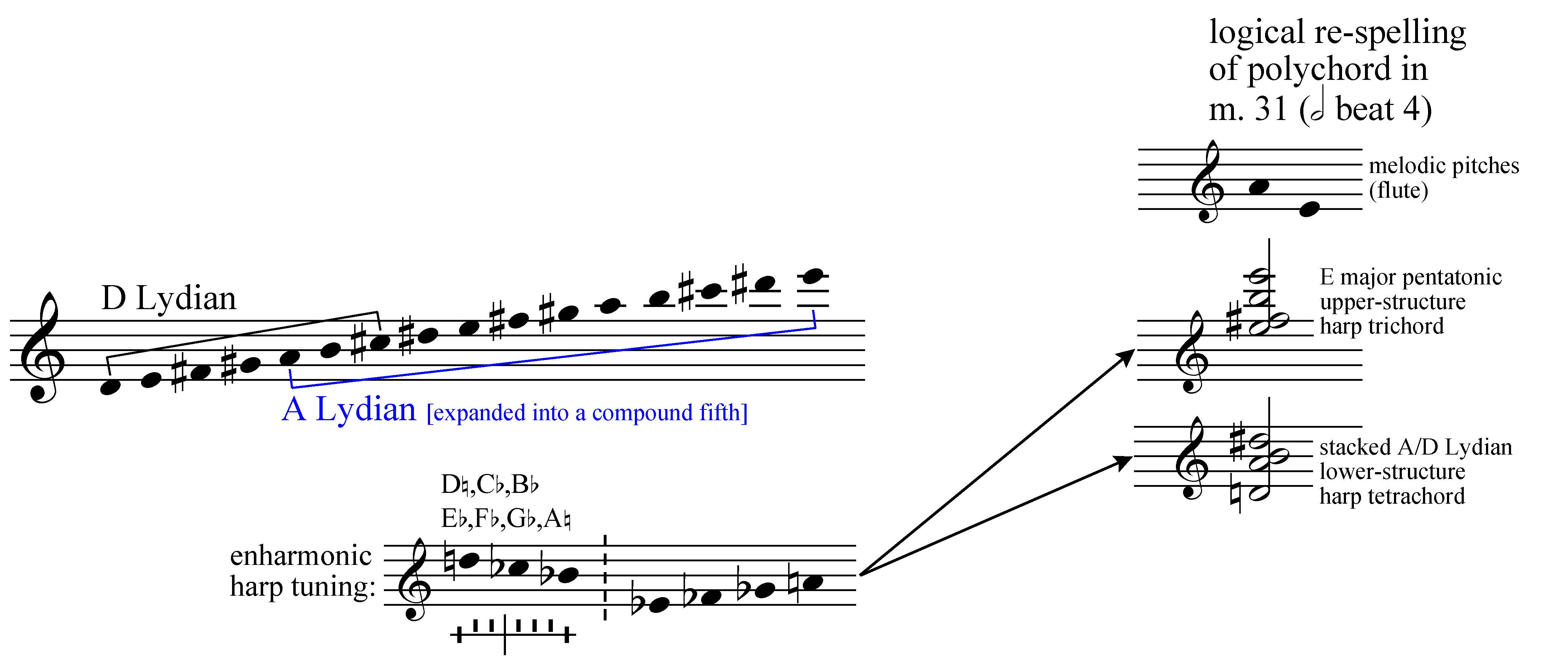
Fig 2.3.3 below is a harmonic/modal model for mm. 24–28 of a previous arrangement of Galargan (Elegy) from Cwyn y Gwynt (The Wind’s Lament) for contralto, vibraphone & cello:

View Fig 2.3.3 in PDF Format
Figures 3.1.1 and 3.1.4 below are harmonic/polymodal models for a couple of similar sections from Iâr fach yr haf (Butterfly) for soprano, flute & pianoforte, set to Sir John Morris-Jones’s Welsh-language translation of a lyric by Heinrich Heine. The ostinato and dovetail patterns are mainly constructed by superimposing multiple transposed modal extractions from the pentatonic scale, to create a synthetic polymodal texture:
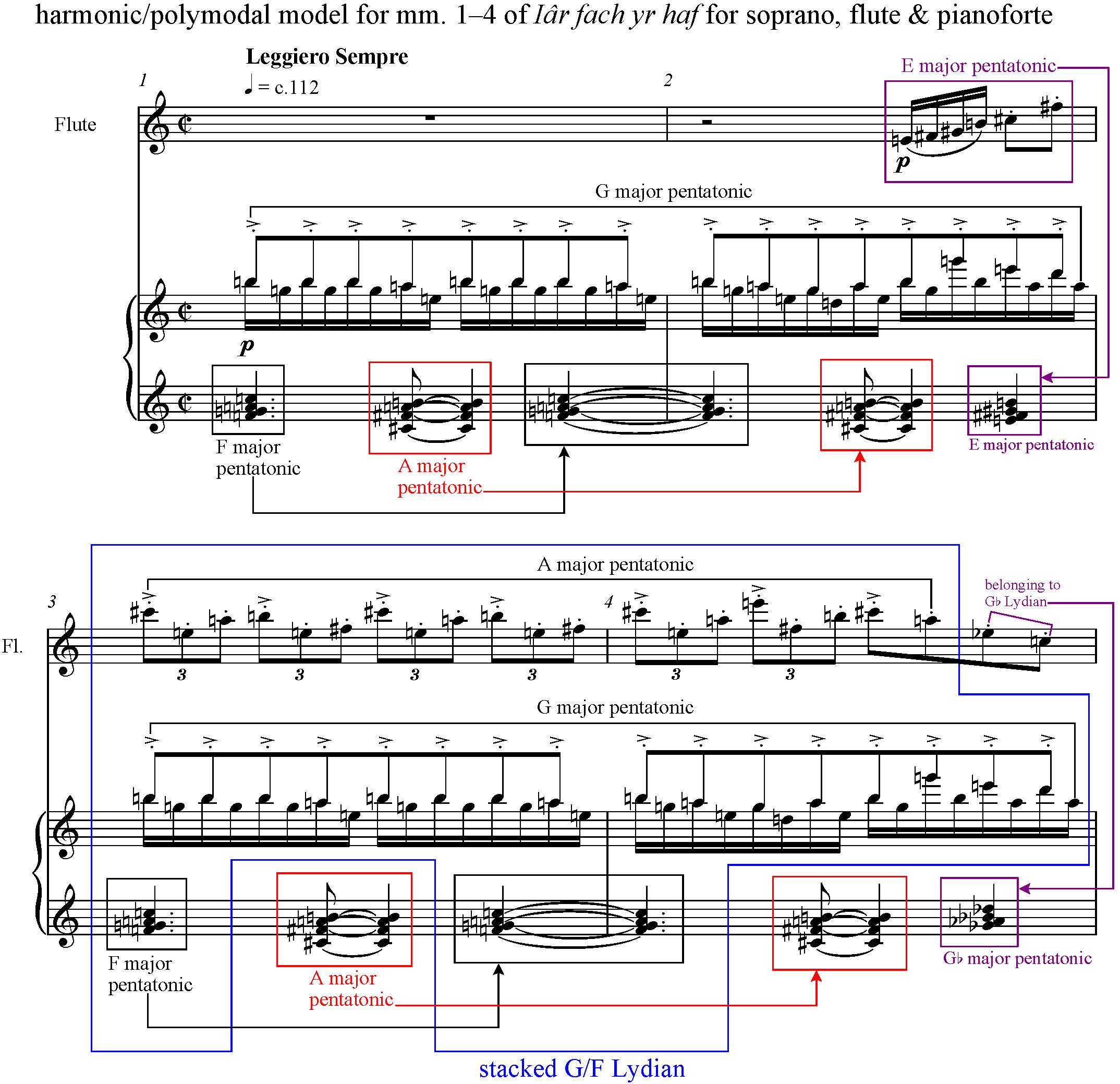
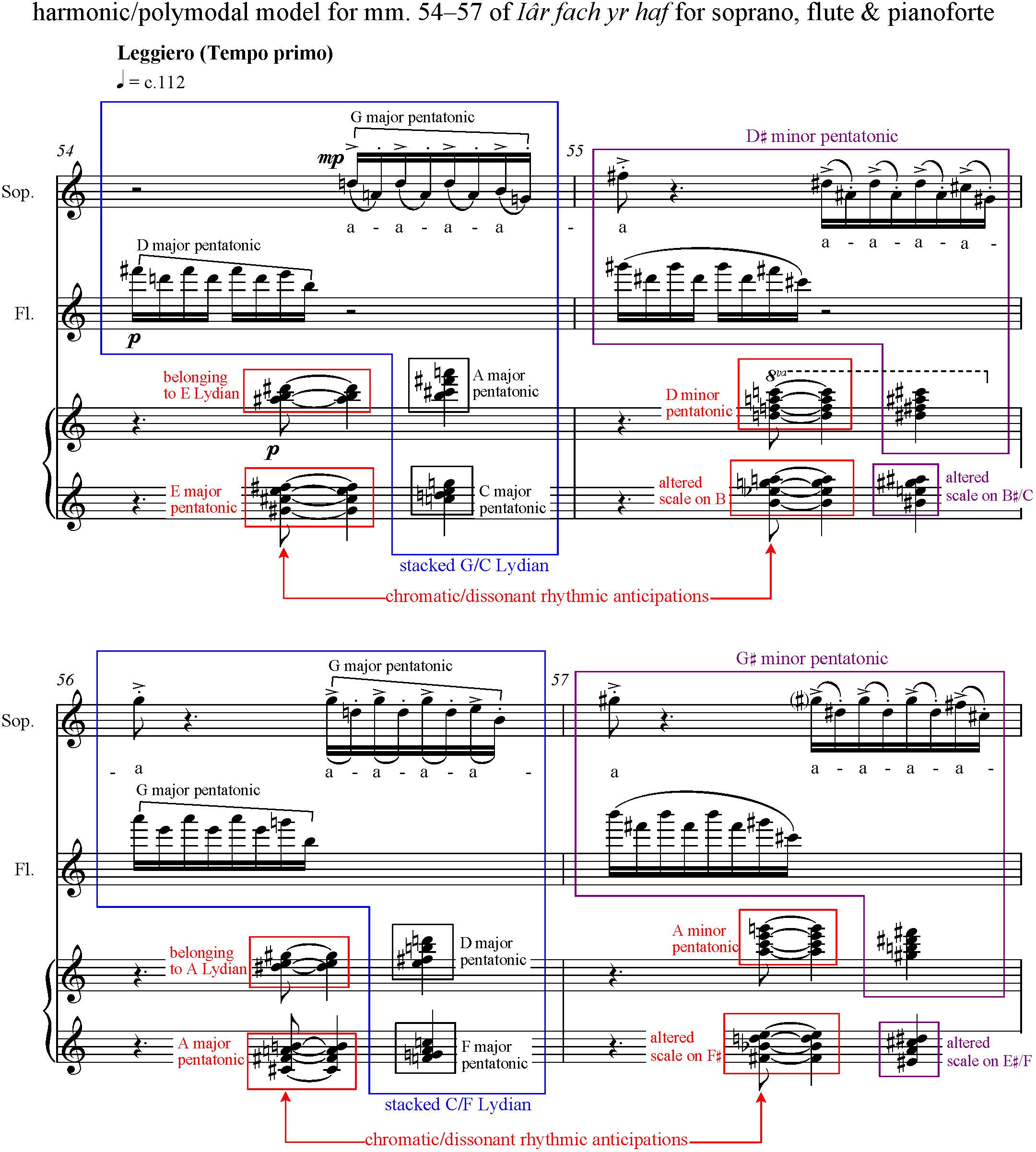
The sum of microtonal frequencies that ring simultaneously at the climax of the middle section of Eternal Owl Call for bass flute & live electronics (mm. 41–43) is shown below in Fig 4.5. This diagram illustrates the origin of the precise microtonal pitches indicated in the electronics part. The electronically generated frequencies use sine waves at a given frequency controlled by a square wave amplitude filter – the resulting sounds are reminiscent of little bells or chimes, which symbolise perpetual judgment, as is relevant to the mythological narrative behind this piece. In addition, the looped 9-note row uses an electronically generated bell algorithm, created using SuperCollider’s ‘Klank’ bell-modelling interface.11 The frequencies in operation are all based on natural harmonics of six separate musical pitch frequencies: namely D♭2–E♭2–F2–G2–C3–D♮3, which make up a 4+2a-cell hexachord on D♭ (as illustrated in Fig 1.4.1). The natural harmonics employed based on this intervallic collection are all prime-numbered partials of the relevant harmonic series (a prime number is an integer that can only be divided by itself or one, i.e. 2nd, 3rd, 5th, 7th, 11th partials of the harmonic series etc...).
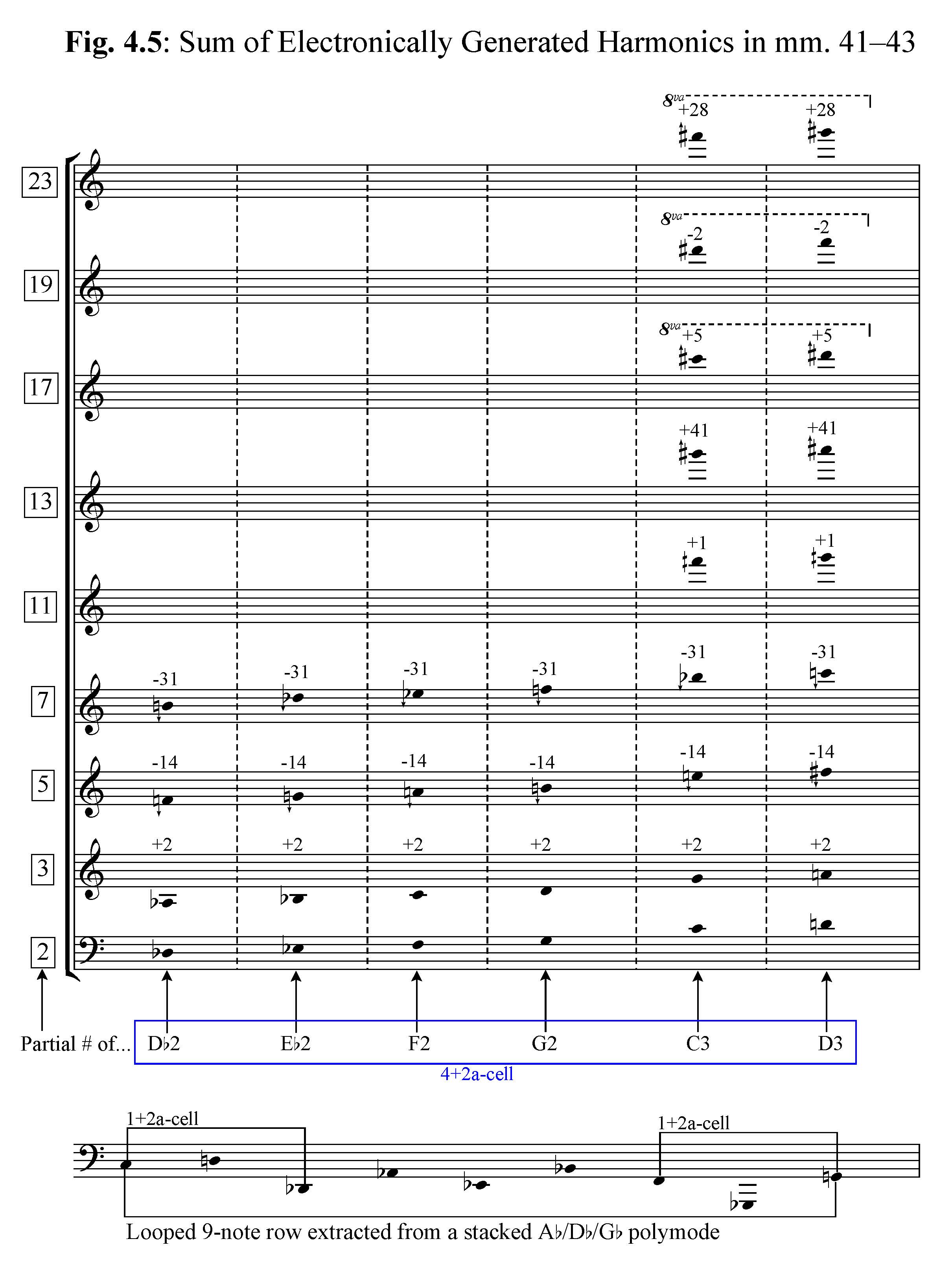
View Fig 4.5 in PDF Format
Figures 5.1.1 and 5.1.4 below are harmonic/polymodal models for a couple of similar sections from Apathetic Machines the first movement of Urban Wilderness for string quartet, showing part of the movement’s exposition and recapitulation section respectively. The recapitulation is a “mirror image” of the exposition; the soloistic melody is moved from the first violin (i.e. the highest pitched voice) to the cello (i.e. the lowest pitch voice) and the musical intervals are inverted:
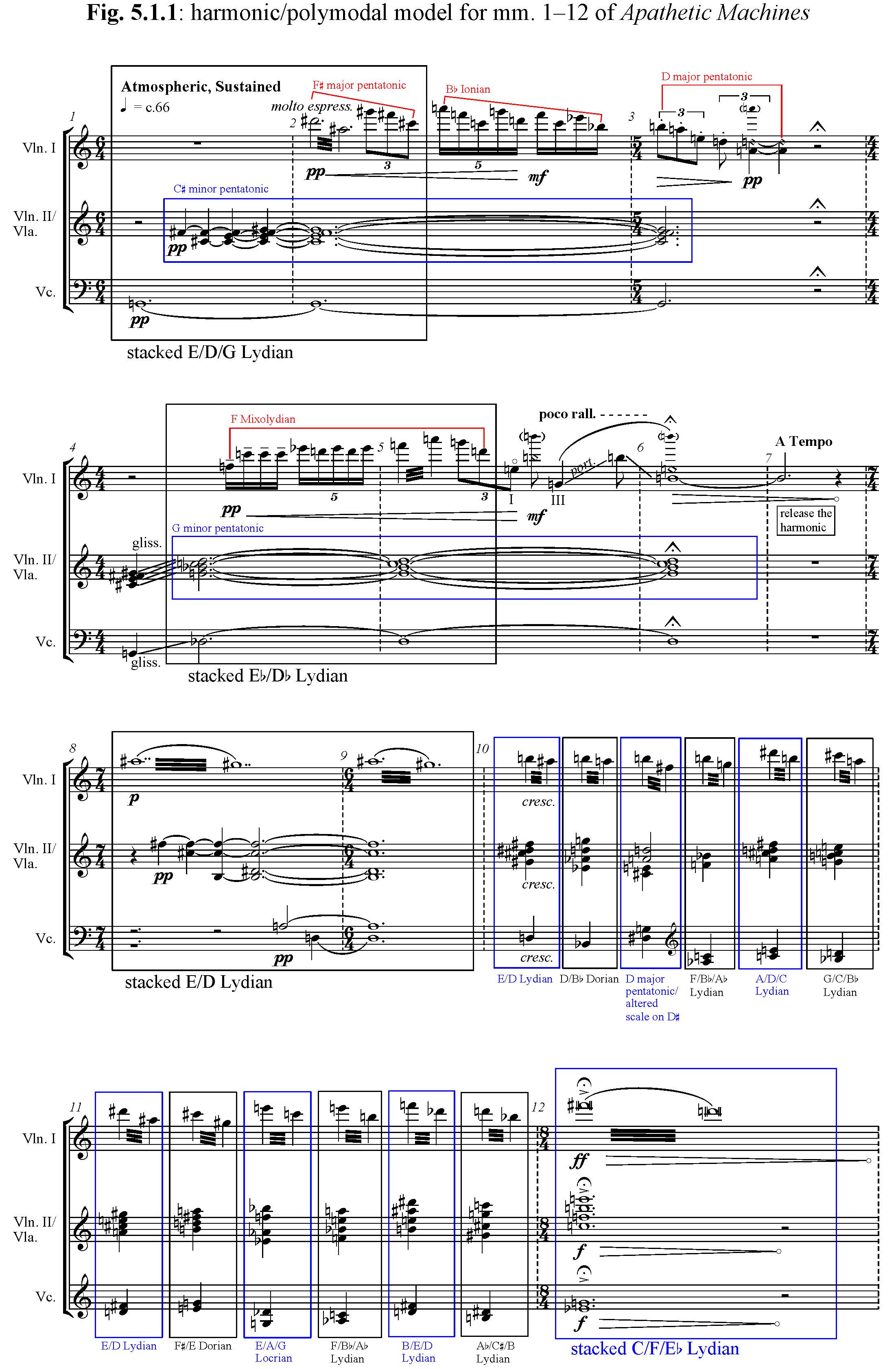
View Fig 5.1.1 in PDF Format
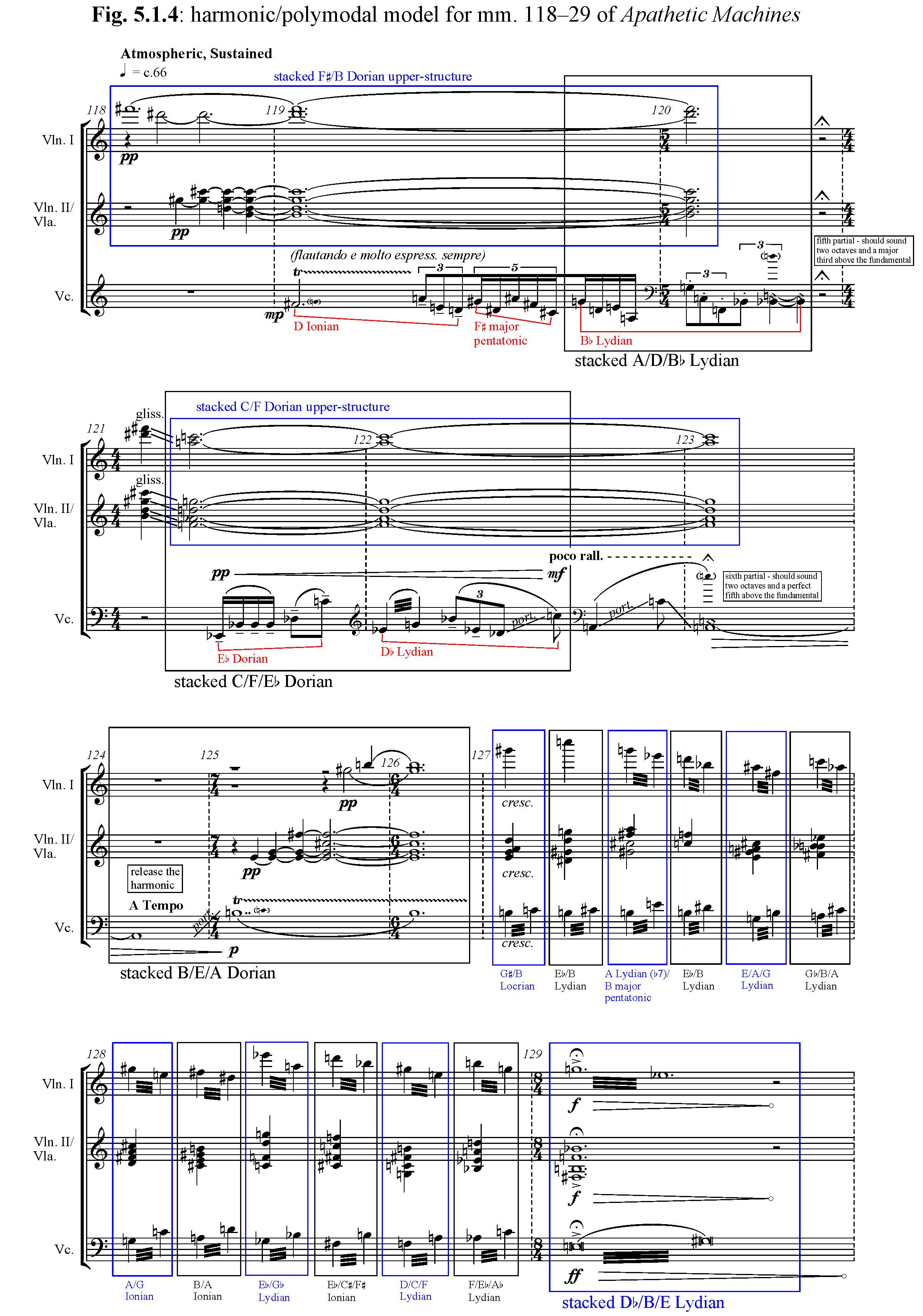
View Fig 5.1.4 in PDF Format
Table of Diatonic Modes (Appendix 1)
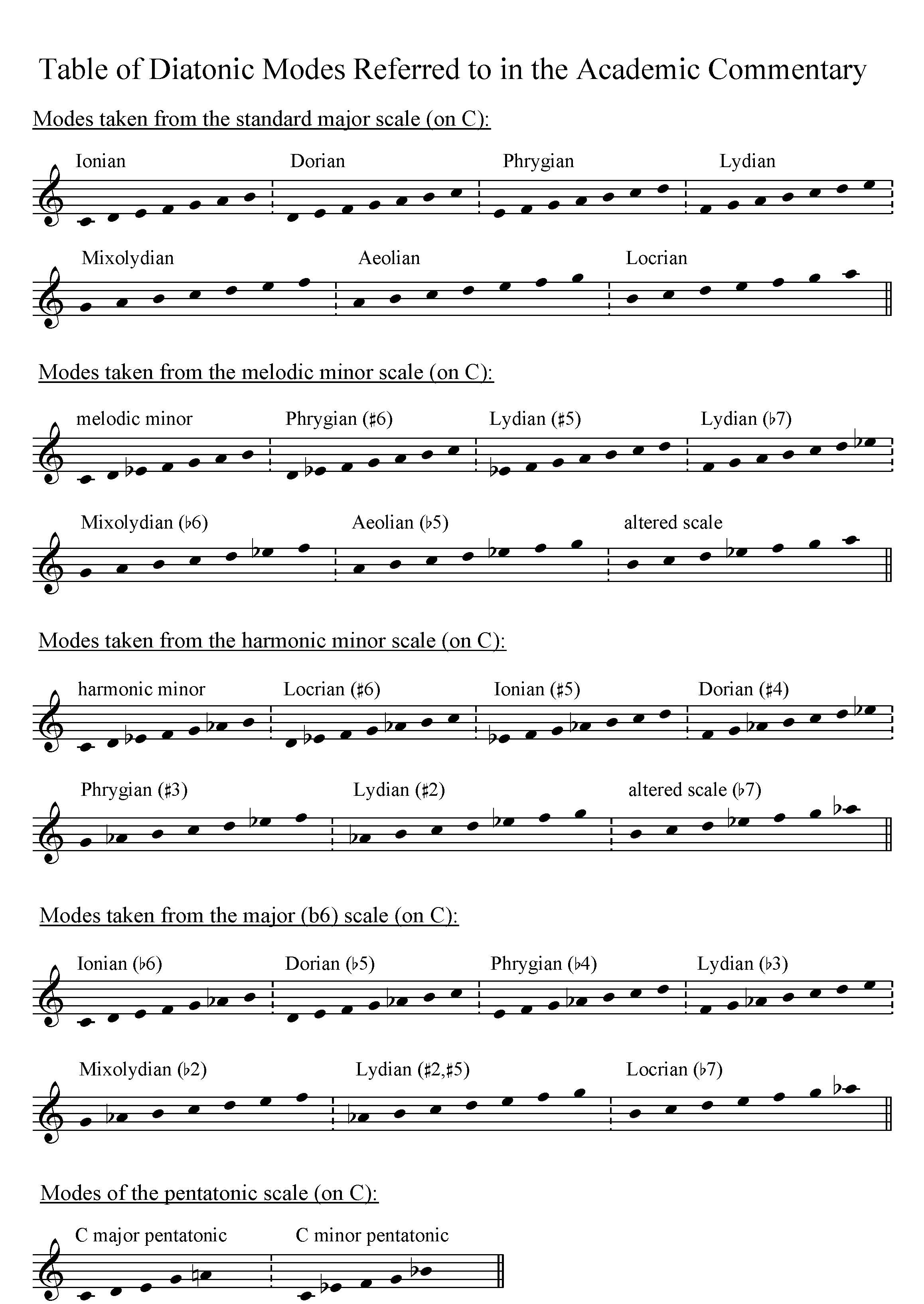
View Appendix 1 in PDF Format
Footnotes
1 This differs from “polytonality” which shares multiple diatonic/non-modal ‘tonal centres’ (i.e. shares multiple major/minor keys).
2 A table containing the 7-note and 5-note diatonic modes discussed in this commentary [namely modes of the major, melodic/harmonic minor, major (♭6) and pentatonic scale respectively] is supplied in Appendix 1.
3 Defined in Olivier Messiaen’s The Technique of My Musical Language (Paris: Alphonse Leduc, 1956) as the ‘first mode of limited transpositions’, vol. 1, p. 59.
4 Ibid., defined as the ‘second mode of limited transpositions’, vol. 1, pp. 59–60 & vol. 2, p. 50.
5 Ibid., vol. 1, p. 59.
6 Ibid.
7 Ibid.
8 Benjamin Suchoff, Bartók’s Mikrokosmos: Genesis, Pedagogy and Style (Lanham, Md: Scarecrow Press, 2002), 115.
9 John Vincent, The Diatonic Modes in Modern Music (Berkeley: University of California Press, 1951), 272.
10 Arnold Whittall, The Cambridge Companion to Serialism (Cambridge: Cambridge University Press, 2008), 272.
11 In the SuperCollider audio synthesis computer programming language, the ‘Klank’ bell-modelling class was preceded by the ‘Klang’ class (which is the German word for “sound” and also shares its name with a well-known acousmatic work by electroacoustic composer Jonty Harrison [composed in 1982], which processes and transforms a recorded acoustic metallic/bell-like sound).